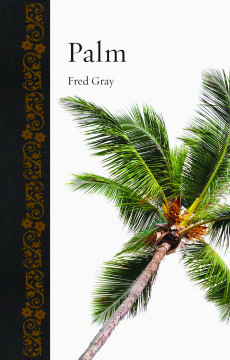
Additional Information
Book Details
Abstract
The extraordinary palm: diverse and prolific, symbolic and often sacred, essential and exotic (and at times erotic), exploited and controversial. The signature greenery of the tropics and subtropics, these record-breaking plants produce the world’s biggest and heaviest seed, the longest leaf, and the longest stem. In the superbly illustrated, similarly extraordinary Palm, Fred Gray portrays the immense cultural and historical significance of these iconic and controversial plants, unfurling a tale as long and beguiling as their bladed fronds.
As Gray shows, palms sustained rainforest communities for thousands of years, contributing to the development of ancient civilizations across the globe. But as palms gained mystical and religious significance, they also became a plant of abstractions and fantasies, a contradictory symbol of leisure and luxury, of escaping civilization and getting closer to nature—and at times to danger and devastation. In the era of industry and empire, the palm and its myriad meanings were exported to far colder climes. Palms were shown off as exceptional performers in iconic greenhouses and used to clothe, romanticize, and glamorize an astonishing diversity of new places far from their natural homelands. And today, as millions of people worldwide consume palm oil daily, the plant remains embedded in consumer society—and mired in environmental controversy.
"A must-read book. Even if you don’t think you’re interested in palms, you should probably know how crucial a role they play in your life. . . . [Palm is] beautifully written and perfectly peppered with good references, photographs, and paintings. It's a pleasure to read, but it wasn't until I got to palms and capitalism that for me this book became something else. . . . What this book teaches, in its mannered and careful approach, is that palm oil is in much more than just biscuits and lipstick, it lubricates the modern world and how it got to play that role is carefully laid out. . . . The palm as a motif is often symbolic of leisure, of opulent exoticism and the remote desert island getaway, and yet in reality it is playing a far more destructive role."
— Alys Flower, Gardens Illustrated
"This is a beautiful book. The hardback binding is pleasing and the page layout and type face all carefully thought out and appropriate. Throughout it is illustrated with beautiful photographs or art reproductions, almost all in color. It is also an easy read, and there is much to stimulate. The links made between palms and literature are sometimes surprising and entertaining. This is the sort of book that would sit well on the bedside table in a palm enthusiast’s guest bedroom. Here is an easily read, palm-themed book, filled with entertaining anecdotes and serious political matter, to while away the time, gently informing the reader about selected aspects of this most magnificent of flowering plant families. It is not an exhaustive introduction to the palm family, but the reader may learn much about the interactions between palms and man, particularly in history, art, culture and trade. At £16 [$27], it is a steal."
— Palms: Journal of the International Palm Society
"There’s not only great depth, there’s also tremendous breadth in this comparatively slim volume, and you never really know where your palm adventures will end up. But, that’s a big part of the delight and surprise in this book, and one which is not only abundantly illustrated, but also stylishly and well-written."
— Botany One
"For anyone wanting to learn more about the palm, there is not much, including trivia, that the author fails to include in this well-written, detailed, entertaining, and intense analysis of the biology, history, geography, diversity, economic significance, cultural impact, and symbolism of this beautiful plant. . . . Part of Reaktion Books’ ambitious Botanical series, which presents various plants from a natural and cultural history perspective, this exhaustively researched volume is appropriate for adult, college, or advanced high school readers. It would be a valuable addition to a classroom library. . . . Profusely illustrated with captivating photographs."
— American Biology Teacher
"This desirable book is elegantly hardbound and brimming with images. . . . An easy read and two chapters dealing primarily with oil palm are informative summaries of the history and current status of this controversial crop. . . . The entertaining final chapter 'Abstractions and Fantasies' on palm symbolism lives up to its title."
— Garden
Fred Gray is professor emeritus of continuing education at the University of Sussex, Brighton. He is the author of Designing the Seaside: Architecture, Society and Nature, also published by Reaktion Books.
Table of Contents
| Section Title | Page | Action | Price |
|---|---|---|---|
| Cover | Cover | ||
| Title Page | 3 | ||
| Imprint Page | 4 | ||
| Contents | 5 | ||
| One: The Prince of Plants | 7 | ||
| Two: Dissecting the Giant Herb | 21 | ||
| Three: The Civilizing Date | 39 | ||
| Four: Western Discovery | 57 | ||
| Five: Empire and Utility | 83 | ||
| Six: Of Tigers, Plantations and Instant Noodles | 105 | ||
| Seven: The Ornamental Palm | 131 | ||
| Eight: Captive Performer | 155 | ||
| Nine: Abstractions and Fantasies | 179 | ||
| Timeline | 198 | ||
| References | 203 | ||
| Further Reading | 215 | ||
| Associations and Websites | 217 | ||
| Acknowledgements | 219 | ||
| Photo Acknowledgements | 221 | ||
| Index | 223 |
